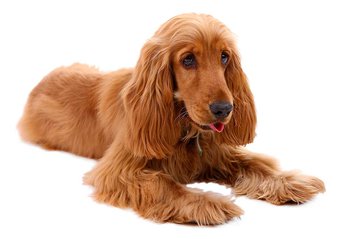A Guide to the Cocker Spaniel
Read our Guide to the Cocker Spaniel! One of the most beautiful breeds of the dog world, the Cocker Spaniel is amenable with a cheerful disposition which also makes him a treat to have in the family. Cocker Spaniels are always pleased when they are pleasing you, the quick to learn, playful breed makes for a great pet in a family of all ages.
 Guide to the Cocker Spaniel
Guide to the Cocker Spaniel
Facts about Cocker Spaniels
- Temperament: Amenable and easily trained
- Social/Attention Needs: High
- Average Life Span: 10-12 years
- Coat length: long
- Grooming required: Daily – especially ears
The Look of Cocker Spaniels
This breed is strong but softly contoured with a dignified and alert expression. The English Cocker Spaniel has medium-sized oval eyes, a cleanly chiselled jaw, and long, leather fine ears covered in silky hair. The body is strong but not heavy with a deep chest.
Cocker Spaniels come in a variety of colours including black, liver, and red as well as part-colour combinations of black and tan, liver and tan, or white with black, liver, or red.
The History of Cocker Spaniels
The modern Cocker Spaniel is descended from the Spaniel family, a large group that dates to antiquity. The word spaniel means “Spanish dog,” and it’s generally believed that they indeed originated in Spain.
By the 1800s, Spaniels were divided into two groups: toys (primarily companions) and large hunting dogs. Hunting dogs were further divided into land and water spaniels. The Cocker Spaniel was named so for his excellence in the field hunting woodcock.
Health problems seen in Cocker Spaniels
All have varying incidences of health problems that may be genetic. Problems that may affect the Cocker Spaniel include the following:
- Progressive Retinal Atrophy
- Hypothyroidism
- Primary seborrhea
- IMHA – Immune-mediated haemolytic anaemia
A fun fact about Cocker Spaniels
A Cocker Spaniel Was the First Cancer-Detecting Dog!
Scientists now know that dogs are capable of identifying cancerous samples by scent, although they are still unsure exactly what the dogs are smelling. This idea was first confirmed by a study done with six dogs in England in 2004. In that study, a Cocker Spaniel named Tangle had the best success rate at detecting cancer, with 56% accuracy. Researchers continued to work with Tangle, and his success rate improved to 80%.


Join the conversation
1 Comment